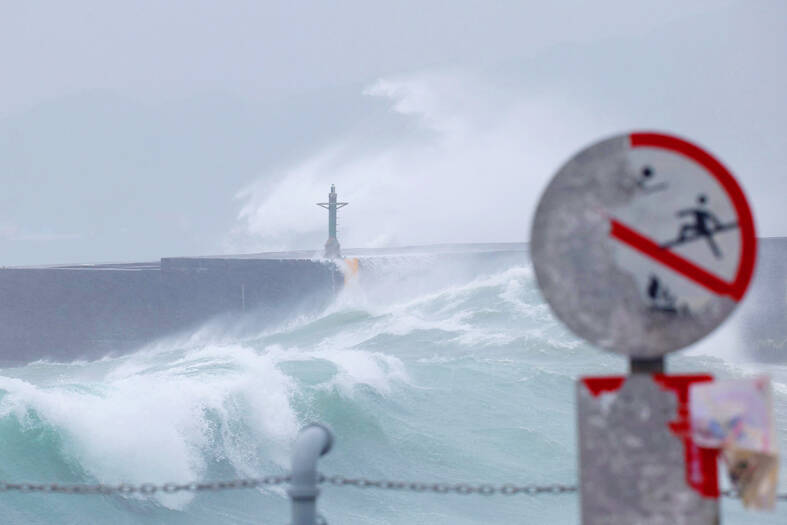Climate change turbocharged the winds and rain of Typhoon Gaemi, which killed dozens of people across Taiwan, the Philippines and China last month, a group of scientists said yesterday.
Gaemi skirted the Philippines, triggering floods and landslides that killed at least 40 people, before making landfall in Taiwan and China.
In China, the weather system caused torrential downpours that killed 50 people and prompted authorities to evacuate 300,000.

Photo: Carlos Garcia Rawlins, Reuters
World Weather Attribution (WWA), a network of scientists who have pioneered peer-reviewed methods for assessing the role of climate change in extreme events, looked at three regions worst affected by the typhoon: the northern Philippines, Taiwan and China’s Hunan Province.
It found the system’s wind speeds were 7 percent more intense due to human-caused climate change, and its rainfall was 14 percent heavier in Taiwan and 9 percent heavier in Hunan.
The study could not draw definitive conclusions about the role of climate change on the rainfall in the Philippines, because of the region’s complex monsoon rain patterns.
Still, they found the warm seas that helped form and fuel Typhoon Gaemi “would have been virtually impossible” in a world that had not warmed to the current 1.2°C above preindustrial levels.
RISING FREQUENCY
The group’s modeling found this warming has already increased the number of similarly strong storms by 30 percent — up from about five per year to six or seven.
“This study confirms what we’ve expected — hotter seas and atmospheres are giving rise to more powerful, longer-lived and deadlier typhoons,” said Ralf Toumi, director of the Grantham Institute-Climate Change and the Environment at Imperial College London.
Teasing out the impact of climate change on tropical cyclones is complicated, but scientists are focusing more work on these weather systems.
WWA’s method involves assessing how unusual an extreme event is, then modeling the likelihood of a similar event and its intensity in two scenarios: today’s world and one without current levels of warming.
The scientists used that method and a new approach developed by Imperial College London that is tailored specifically to tropical storms.
It uses computer modeling to overcome the relative lack of historical data on tropical cyclones.
PREPAREDNESS
While the Asia-Pacific region has long dealt with typhoons, the scientists warned that their work highlighted “gaps in typhoon preparedness and the massive impacts caused by Gaemi.”
They called for better urban flood management and targeted warnings that offer more information on the likely impacts of a storm.

An essay competition jointly organized by a local writing society and a publisher affiliated with the Chinese Communist Party (CCP) might have contravened the Act Governing Relations Between the People of the Taiwan Area and the Mainland Area (臺灣地區與大陸地區人民關係條例), the Mainland Affairs Council (MAC) said on Thursday. “In this case, the partner organization is clearly an agency under the CCP’s Fujian Provincial Committee,” MAC Deputy Minister and spokesperson Liang Wen-chieh (梁文傑) said at a news briefing in Taipei. “It also involves bringing Taiwanese students to China with all-expenses-paid arrangements to attend award ceremonies and camps,” Liang said. Those two “characteristics” are typically sufficient

A magnitude 5.9 earthquake that struck about 33km off the coast of Hualien City was the "main shock" in a series of quakes in the area, with aftershocks expected over the next three days, the Central Weather Administration (CWA) said yesterday. Prior to the magnitude 5.9 quake shaking most of Taiwan at 6:53pm yesterday, six other earthquakes stronger than a magnitude of 4, starting with a magnitude 5.5 quake at 6:09pm, occurred in the area. CWA Seismological Center Director Wu Chien-fu (吳健富) confirmed that the quakes were all part of the same series and that the magnitude 5.5 temblor was

The brilliant blue waters, thick foliage and bucolic atmosphere on this seemingly idyllic archipelago deep in the Pacific Ocean belie the key role it now plays in a titanic geopolitical struggle. Palau is again on the front line as China, and the US and its allies prepare their forces in an intensifying contest for control over the Asia-Pacific region. The democratic nation of just 17,000 people hosts US-controlled airstrips and soon-to-be-completed radar installations that the US military describes as “critical” to monitoring vast swathes of water and airspace. It is also a key piece of the second island chain, a string of

The Central Weather Administration has issued a heat alert for southeastern Taiwan, warning of temperatures as high as 36°C today, while alerting some coastal areas of strong winds later in the day. Kaohsiung’s Neimen District (內門) and Pingtung County’s Neipu Township (內埔) are under an orange heat alert, which warns of temperatures as high as 36°C for three consecutive days, the CWA said, citing southwest winds. The heat would also extend to Tainan’s Nansi (楠西) and Yujing (玉井) districts, as well as Pingtung’s Gaoshu (高樹), Yanpu (鹽埔) and Majia (瑪家) townships, it said, forecasting highs of up to 36°C in those areas